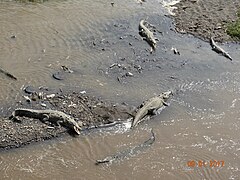312:
324:
288:
300:
262:. The total list known of birds well exceeds 320 species including the little known Guacalillo Canals. The avian biodiversity is substantial including rare birds such as Agami Heron, Rufous-necked Woodrail, Jabiru, Yellow-billed Cotinga and recently found an Orinoco Goose. It's also home of Howler and White-faced Capuchin Monkeys. Less commonly seen are Silky Anteater, Sloths, Grinson, Jaguarundi, River Otter and Northern Tamandua.
29:
458:
356:
116:
203:
covers an area of 2,121 square kilometres (819 sq mi), which encompasses around 50% of the country's population.
374:
451:
482:
192:
76:
477:
444:
311:
323:
287:
299:
259:
251:
247:
432:
219:
8:
266:
223:
243:
211:
The river's watershed drains approximately 67% of Costa Rica's untreated organic and
212:
398:
274:
428:
255:
200:
196:
102:
471:
131:
118:
231:
87:
188:
47:
227:
215:
and is considered the most contaminated river basin in the country.
28:
278:
270:
195:
volcanic range and flows in a south-westerly direction to the
239:
235:
226:, while the marshes located at the river's mouth have many
375:"Tárcoles: The most contaminated river in Central America"
218:
The river's upper reaches form the northern border of the
199:. The river is 111 kilometres (69 mi) long and its
427:
This article related to a river in Costa Rica is a
357:"Tárcoles River Basin, Costa Rica: Background Paper"
372:
354:
469:
452:
350:
348:
346:
344:
459:
445:
341:
191:originates on the southern slopes of the
470:
250:, and other birds found here include
422:
373:Sebastian Rodriguez (1 March 2017).
169:2,121 km (819 sq mi)
13:
14:
494:
322:
310:
298:
286:
27:
391:
366:
110: • coordinates
1:
334:
54:Physical characteristics
431:. You can help Knowledge by
355:Ballestero, Maureen (2003).
305:An American Pygmy Kingfisher
149: • elevation
7:
98: • location
72: • location
10:
499:
421:
403:Mangrove Birding Journeys
260:American pygmy kingfisher
252:double-striped thick-knee
248:bare-throated tiger heron
206:
165:
157:
147:
108:
96:
86:
82:
70:
62:
58:
53:
43:
38:
26:
21:
281:, are also easily seen.
181:Grande de Tárcoles River
161:111 km (69 mi)
483:Costa Rica river stubs
265:Reptiles, such as the
222:. It is a habitat for
185:Río Grande de Tarcoles
132:9.786315°N 84.641175°W
293:Reptiles in the river
33:View from near Carara
478:Rivers of Costa Rica
220:Carara National Park
153:0 m (0 ft)
137:9.786315; -84.641175
224:American crocodiles
128: /
16:River in Costa Rica
267:American crocodile
193:Cordillera Central
179:, also called the
77:Cordillera Central
440:
439:
234:. Among the many
173:
172:
490:
461:
454:
447:
423:
413:
412:
410:
409:
395:
389:
388:
386:
385:
370:
364:
363:
362:. worldbank.org.
361:
352:
326:
314:
302:
290:
256:mangrove warbler
213:industrial waste
143:
142:
140:
139:
138:
133:
129:
126:
125:
124:
121:
73:
31:
19:
18:
498:
497:
493:
492:
491:
489:
488:
487:
468:
467:
466:
465:
419:
417:
416:
407:
405:
397:
396:
392:
383:
381:
371:
367:
359:
353:
342:
337:
330:
327:
318:
315:
306:
303:
294:
291:
275:common basilisk
209:
150:
136:
134:
130:
127:
122:
119:
117:
115:
114:
111:
99:
71:
34:
17:
12:
11:
5:
496:
486:
485:
480:
464:
463:
456:
449:
441:
438:
437:
415:
414:
390:
365:
339:
338:
336:
333:
332:
331:
328:
321:
319:
316:
309:
307:
304:
297:
295:
292:
285:
208:
205:
197:Gulf of Nicoya
177:Tárcoles River
171:
170:
167:
163:
162:
159:
155:
154:
151:
148:
145:
144:
112:
109:
106:
105:
103:Gulf of Nicoya
100:
97:
94:
93:
90:
84:
83:
80:
79:
74:
68:
67:
64:
60:
59:
56:
55:
51:
50:
45:
41:
40:
36:
35:
32:
24:
23:
22:Tárcoles River
15:
9:
6:
4:
3:
2:
495:
484:
481:
479:
476:
475:
473:
462:
457:
455:
450:
448:
443:
442:
436:
434:
430:
425:
424:
420:
404:
400:
394:
380:
376:
369:
358:
351:
349:
347:
345:
340:
325:
320:
313:
308:
301:
296:
289:
284:
283:
282:
280:
276:
272:
268:
263:
261:
257:
253:
249:
245:
241:
237:
233:
229:
225:
221:
216:
214:
204:
202:
198:
194:
190:
186:
182:
178:
168:
164:
160:
156:
152:
146:
141:
113:
107:
104:
101:
95:
91:
89:
85:
81:
78:
75:
69:
65:
61:
57:
52:
49:
46:
42:
37:
30:
25:
20:
433:expanding it
426:
418:
406:. Retrieved
402:
393:
382:. Retrieved
378:
368:
264:
232:wading birds
217:
210:
184:
180:
176:
174:
329:Snowy egret
317:Royal terns
135: /
472:Categories
408:2022-06-05
399:"MBJ HOME"
384:2019-02-05
335:References
277:and large
189:Costa Rica
166:Basin size
123:84°38′28″W
48:Costa Rica
228:waterfowl
201:watershed
120:9°47′11″N
244:boatbill
242:are the
39:Location
279:iguanas
183:or the
44:Country
271:caiman
240:egrets
236:herons
207:Course
158:Length
92:
66:
63:Source
360:(PDF)
187:, in
88:Mouth
429:stub
379:AIDA
258:and
246:and
238:and
230:and
175:The
474::
401:.
377:.
343:^
273:,
269:,
254:,
460:e
453:t
446:v
435:.
411:.
387:.
Text is available under the Creative Commons Attribution-ShareAlike License. Additional terms may apply.




